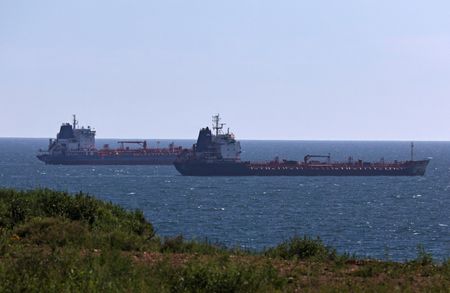(Reuters) – Russian oil exports to the European Union fell by 430,000 barrels per day to 1.4 million bpd in November from the previous month, according to the International Energy Agency (IEA).
Russian seaborne crude volumes dropped by 330,000 bpd to 500,000 bpd, below Druzhba pipeline deliveries of 590,000 bpd for the first time, it said in a monthly oil market report.
As a result, the EU’s share of Russian crude oil exports fell to 28% in November from 31% in October, and from 50% before Moscow’s invasion of Ukraine on Feb. 24.
Meanwhile, Russian crude exports to India reached a record of 1.3 million bpd in November, while exports to China, including seaborne and pipeline, were broadly unchanged at 1.9 million bpd.
On Dec. 5, the EU ban on Russian crude imports and a G7 price cap on Russian seaborne exports at $60 per barrel came into effect, which is expected to reduce Russia’s output.
Exports of Russian crude via Druzhba pipeline to eastern Europe are exempt from the ban, but the IEA expects already reduced supplies to fall further forcing Russia to shut in more production.
Some 100,000 bpd of Russian seaborne crude exports are also excluded from the EU ban, according to the IEA.
Graphic: Russia oil exports by destination https://www.reuters.com/graphics/RUSSIA-OIL/OIL/jnpwyyxympw/chart.png
ALTERNATIVE SUPPLIES
The EU is seeking to offset the decline in Russian crude imports by increasing supplies from the Middle East, West Africa, Norway, Brazil and Guyana, the IEA has said.
The United States and Kazakhstan could help to replace the approximately 1.1 million bpd of Russian oil that will be lost after Dec. 5, according IEA estimates in its previous report in November.
Norway also plans to ramp up output from Western Europe’s largest oilfield, Johan Sverdrup, in December. The field’s Phase 2 development could add 200,000 bpd when it reaches the peak next year, its operator Equinor has said.
COMPLICATIONS
Some Russian oil will continue to flow into the EU via pipelines as the ban excludes some landlocked refineries in eastern Europe.
Germany, the Netherlands and Poland were the top importers of Russian oil in Europe last year, but all have capacity to import seaborne crude from elsewhere.
The EU’s dependence on Russia has also been underpinned as companies such as Rosneft and Lukoil control some of the bloc’s largest refineries. Germany, however, has taken control of the Rosneft-owned Schwedt refinery, which supplies about 90% of Berlin’s fuel needs, while the Lukoil-owned ISAB refinery in Sicily could be sold by the end of the year.
EU countries that received temporary exemptions to import Russian crude oil are not allowed to export products obtained from this feedstock.
Bulgaria, Slovakia and Hungary have all considered the potential impact on run rates of this restriction and are seeking to arrange exemptions for trading any excess products, the IEA said.
(Compiled by Nerijus Adomaitis; editing by Barbara Lewis)

